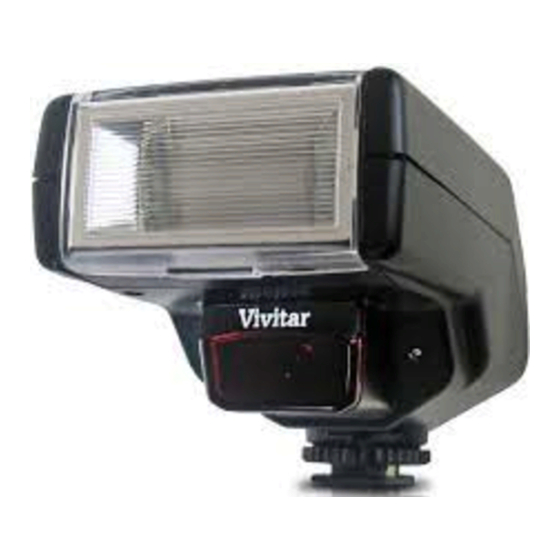
Table of Contents
Advertisement
Quick Links
Advertisement
Table of Contents

Summary of Contents for Vivitar VIV-DF-186
- Page 1 Bounce Swivel Speedlight DSLR Flash INSTRUCTION MANUAL VIV-DF-186...
- Page 2 Vivitar warrants this quality product to be free of defects in material and workmanship for a period of one year from the date of purchase. During the period, Vivitar will repair or replace the product at no charge for parts or labor.
- Page 3 When service is complete, the product will be returned to you shipping prepaid. In the event the product is deemed to be not faulty or the defect is a result in wear and tear, Vivitar may levy a handling charge for the return ofthe product.
- Page 4 Introduction Congratulations on your purchase of the Vivitar VIV-DF-186 flash unit. This electronic flash is innovatively designed for both digital cameras, with advanced technology used to control the correct amount of light output. Please kindly take a few minutes to read this instruction manual before using.
- Page 5 Important Notes for Flash Photography and Maintenance 1. After each picture, wait for two seconds for the flash to fully recharge before taking the next shot, even when the ready light is on. This will help to prolong the lifespan of the flash tube.
- Page 6 Important Notes for Flash Photography and Maintenance (cont.) 6. Always use a fresh set of 4 AA batteries of the same brand and type when old batteries are depleted. Mixing and matching batteries of different types or brands will greatly deteriorate the flash’s performance.
-
Page 7: Installing Batteries
Installing Batteries In order to power on your flash, you will first need to install batteries. To do so, first ensure that the ON/OFF switch is in the OFF position. Next, open the battery compartment, and insert 4 new AA batteries with the correct polarity (+,-) as indicated inside the battery compartment. - Page 8 Mounting the Flash Onto Your Camera Once batteries are inserted into your flash, you can proceed to mount it onto your camera. To do so, first ensure that the ON/OFF swtch is in the OFF position. Next, slide the flash’s hotshoe base onto the camera’s hot shoe then rotate the lock ring until it is fastened securely.
-
Page 9: Power Saving Function
Auto Check Light The Green Auto Check Light (OK) located on the back of the flash is used to confirm that your subject is within the effective TTL range of the flash unit. If your subject is within the effective TTL flash range after shooting, the green Auto Check Light will illuminate for approximately 2 seconds. - Page 10 PROGRAM TTL (P) / AUTO MODE This flash unit provides automatic Through-The-Lens (TTL) control of the flash exposure when used with dedicated digital cameras. When using this mode, the flash unit will automatically emit the flash output for a balanced illumination of the subject and background.
- Page 11 TTL AV, TV AND M MODES When this flash unit is used with your camera set to AV, TV or M modes, the flash exposure will be automatically controlled by the camera based on the combination of shutter speed and aperture value. *For TV mode, do not exceed the camera’s maximum flash synchronization speed.
- Page 12 SECOND/REAR CURTAIN SYNCHRONIZATION This mode permits you to fire the flash just before your camera’s shutter closes during slow shutter speed shooting. This will create a trail of lighting that will be appear behind the main subject when a slow shutter speed is being used. *For more information on rear curtain synchronization settings, refer to your camera’s instruction manual.
-
Page 13: Red-Eye Reduction
RED EYE REDUCTION When red eye reduction is activated on the DSLR body, the flash unit will activate a series of preflashes before the main flash to reduce the possibility of red eye occurrence during shooting. -12-... - Page 14 USING THE BOUNCE HEAD USING THE SWIVEL HEAD Various combinations of bounce angles Once the flash is attached to your can be used to cut off unwanted camera you can use the swivel head to shadows or for special soft effect aim the light in different directions, purposes.
-
Page 15: Specifications
AF Illumination: 8m / 26ft • Autofocus Infra-Red Assistance beam Dedication: • Bounce and swivel construction - For Canon (model VIV-DF-186-CAN): E-TTL/E-TTL II • Automatic shutter speed setting - For Nikon (model VIV-DF-186-NIK): iTTL •Auto check (Ok) indicator - For Sony (model VIV-DF-186-SON): A-Mount •...















Need help?
Do you have a question about the VIV-DF-186 and is the answer not in the manual?
Questions and answers